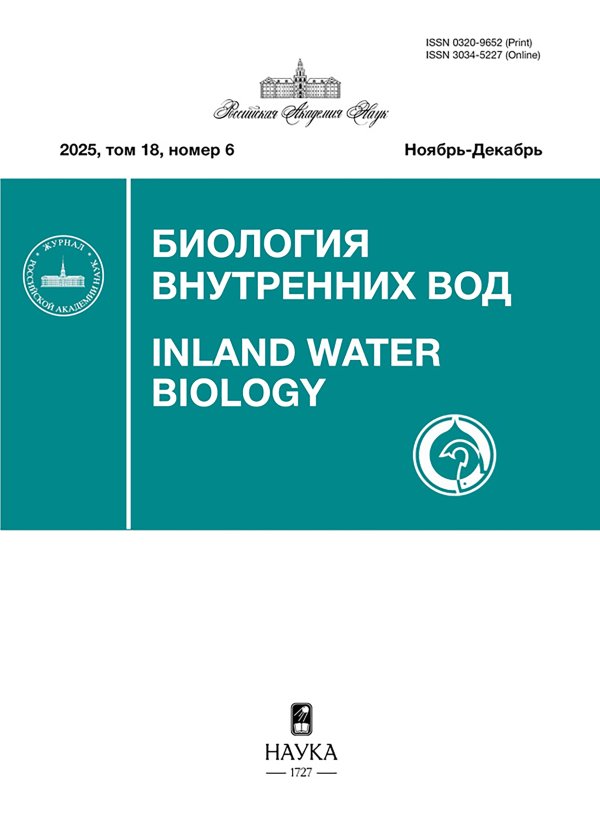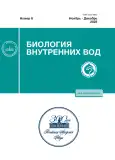Composition and Content of Carotenoids of Gastropod Tritia reticulata in Black Sea
- Authors: Borodina A.V.1, Zadorozhny P.A.2
-
Affiliations:
- Institute of Biology of Southern Seas, Russian Academy of Sciences
- Institute of Chemistry, Far Eastern Branch of Russian Academy of Sciences
- Issue: No 6 (2023)
- Pages: 884-891
- Section: ЭКОЛОГИЧЕСКАЯ ФИЗИОЛОГИЯ И БИОХИМИЯ ГИДРОБИОНТОВ
- URL: https://journals.rcsi.science/0320-9652/article/view/232400
- DOI: https://doi.org/10.31857/S0320965223060062
- EDN: https://elibrary.ru/KEEEAB
- ID: 232400
Cite item
Full Text
Abstract
The results of a two–year study of the composition and content of carotenoids of sea snails Tritia reticulata (L., 1758), living in a mixed bottom community of bivalve mollusks in the sandy zone of the upper sublitoral (depth 0–1 m) of the Cossack Bay of Sevastopol, are presented. The highest content of total carotenoids was detected in June (1.8–2.09 mg/100 g of crude mass), the average Cossack Baymples for both years was 1.54 mg/100 g of crude mass. In the qualitative composition of T. reticulata taken from the pastures of bivalves on sandy-silt soil, 15 free carotenoids were identified: b-carotene, echinenone, hydroxyechinenone, astaxanthin, didehydroastaxanthin, diadinoxanthin, diatoxanthin, fucoxanthin, halocintiaxanthin, fucoxanthinol, mactraxanthin, heteroxanthin, lutein, zeaxanthin, alloxanthin and esters of the last 4 carotenoids. The po-ssibility of metabolic transformations of carotenoids is discussed.
About the authors
A. V. Borodina
Institute of Biology of Southern Seas, Russian Academy of Sciences
Author for correspondence.
Email: borodinaav@mail.ru
Russia, Sevastopol
P. A. Zadorozhny
Institute of Chemistry, Far Eastern Branch of Russian Academy of Sciences
Email: borodinaav@mail.ru
Russia, Vladivostok
References
- Бондарев И.П., Ревков Н.К. 2018. Консорты брюхоногого моллюска Rapana venosa (Valenciennes, 1846) в северной части Черного моря. Ч. III: Mollusca (Gastropoda) // Морской биол. журн. Т. 3. № 1. С. 23. https://doi.org/10.21072/mbj.2018.03.1.03
- Бриттон Г. 1986. Биохимия природных пигментов: М.: Мир.
- Еремеев В.Н., Гаевская А.В., Шульман Г.Е., Загородняя Ю.А. 2011. Промысловые биоресурсы Чѐрного и Азовского морей // НАН Украины, Институт биологии южных морей НАН Украины. Севастополь: ЭКОСИ-Гидрофизика.
- Карнаухов В.Н. 1988. Биологические функции каротиноидов. М.: Наука.
- Киселева М.И. 1981. Бентос рыхлых грунтов. Киев: Наукова думка.
- Макаров М.В. 2018. Таксоцен Mollusca в эпифитоне морской травы Zostera sp. в акватории бухты Казачья (Черное море) // Экологическая безопасность прибрежной и шельфовой зон моря. Вып. 3. С. 92. https://doi.org/10.22449/2413-5577-2018-3-92-97
- Смирнова Л.Л., Кошкаров А.А., Сизова О.С. 2021. Развитие сообществ обрастания на антропогенных поверхностях в прибрежных водах Черного моря // Биология внутр. вод. № 5. С. 461. https://doi.org/10.31857/S0320965221040136
- Чухчин В.Д. 1984. Экология брюхоногих моллюсков Черного моря. Киев: Наукова думка.
- Borodina A.V. 2022. Features of Carotenoid Profile in Black Sea Bivalve Mollusks // J. Evol. Biochem. Physiol. V. 58. № 4. P. 943. https://doi.org/10.1134/S0022093022040019
- Borodina A.V., Zadorozhny P.A. 2020. The Annual Dynamics of Tissue Carotenoids in a Bivalve Mollusk Cerastoderma glaucum (Bruguière, 1789) // J. Evol. Biochem. Physiol. V. 56. № 1. P. 1. https://doi.org/10.1134/S0022093020010019
- Borodina A.V., Zadorozhny P.A. 2021. Seasonal Dynamics of Carotenoids in the Black Sea Bivalve Mollusk Chamelea gallina (Linnaeus, 1758) // J. Evol. Biochem. Physiol. V. 57. № 3. P. 503. https://doi.org/10.1134/S0022093021030054
- Borodina A.V., Zadorozhny P.A. 2022. Distinctive Variations in Carotenoid Accumulation in Tissues of the Clam Polititapes aureus (Gmelin, 1791) from the Black Sea // Russ. J. Mar. Biol. V. 48. № 5. P. 393.
- https://doi.org/10.1134/S1063074022050145
- Borodina A.V., Maoka T., Soldatov A.A. 2013. Composition and content of carotenoids in body of the Black Sea gastropod Rapana venosa (Valenviennes, 1846) // J. Evol. Biochem. Physiol. V. 49. № 3. P. 283. https://doi.org/10.1134/S002209301303002X
- Britton G., Liaaen-Jensen S., Pfander H. 1995. Carotenoids. V. 1A: Isolation and Analysis. Basel: Birkauser.
- Fiordelmondo E., Roncarati A., Vincenzetti S. et al. 2020. Sterol and mineral profiles of the Common Sea Snail Hinia reticulate and the Long Sea Snail Nassarius mutabilis (Gastropods) Collected from the Middle Adriatic Sea // Current Res. Nutrition Food Sci. V. 8. № 3. P. 757. https://doi.org/10.12944/CRNFSJ.8.3.08
- Goodwin T.W. 1984. The biochemistry of the carotenoids: animals. L.: Chapman and Hall.
- Karnaukhov V.N., Milovidova N.Y., Kargopolova I.N. 1977. On a role of carotenoids in tolerance of sea molluscs to environment pollution // Comp. Biochem. Physiol. A Comp. Physiol. V. 56. № 2. P. 189. https://doi.org/10.1016/0300-9629(77)90183-9
- Maoka T. 2011. Carotenoids in Marine Animals // Mar. Drugs. V. 9. № 2. P. 278.https://doi.org/10.3390/md9020278
- Maoka T., Akimoto N., Yim M.J. et al. 2008. New C37 skeletal carotenoid from the clam, Paphia amabillis // J. Agricult. Food Chem. V. 56. № 24. P. 12069. https://doi.org/10.1021/jf802717b
- Maoka T., Akimoto N., Tsushima M. et al. 2011. Carotenoids in Marine Invertebrates Living along the Kuroshio Current Coast // Mar. Drugs. V. 9. № 8. P. 1419. https://doi.org/10.3390/md9081419
- Matsuno T., Katagiria K., Maoka T., Komori T. 1985. Novel reductive metabolic pathways of 4-oxo-b-end group in carotenoids of the spindle shell Fusinus perplexus // Comp. Biochem. Physiol. V. 81B. № 4. P. 905.
- https://doi.org/10.1016/0305-0491(89)90333-7
- Matsuno T., Tsushima M. 1989. Carotenoids of shellfishes-X. Reductive metabolic pathways of echinenone and fritschiellaxanthin in the spindle shell Fusinus perplexus // Comp. Biochem. Physiol. Part B. V. 92. № 1. P. 189. https://doi.org/10.1016/0305-0491(89)90333-7
- Nitsche H. 1973. Heteroxanthin in Euglena gracilis // Archiv. Mikrobiol. V. 90. № 2. P. 151. https://doi.org/10.1007/BF00414517
- Shahidi F., Brown J.A. 1998. Carotenoid pigments in seafoods and aquaculture // Crit. Rev. Food Sci. Nutr. V. 38. № 1. P. 1. https://doi.org/10.1080/10408699891274165
- Partali V., Tangen K., Liaaen-Jensen S. 1989. Carotenoids in food chain studies – III. Resorption and metabolic transformation of carotenoids in Mytilus edulis (Edible mussel) // Comp. Biochem. Physiol. V. 92B. № 2. P. 239. https://doi.org/10.1016/0305-0491(89)90272-1
Supplementary files













